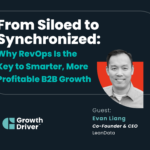Go-to-market strategies have shifted dramatically in recent years, with Account-Based Experiences (ABM/ABX) and Demand Generation emerging as complementary pillars of B2B success. ABM/ABX focuses on personalized engagement and aligning stakeholders across Accounts, while Demand Generation ensures a steady pipeline of qualified prospects. Together, they emphasize the need for a unified and holistic view of all stakeholders within an Account.
The Salesforce Lead Object often divides opinions among MarOps, SalesOps, and RevOps professionals. Traditionally, it’s been used to manage Marketing Qualified Leads (MQLs) or early-stage prospects. However, as marketing automation platforms (MAPs) and CRM integrations have evolved, the role of the Lead Object warrants a fundamental rethink. In some situations completely removing the Lead Object from integration and use is a necessary business requirement. However, instead of eliminating it outright—as some industry voices suggest—we propose repurposing it as a processing system for new person or account records entering your CRM.
This approach capitalizes on the strengths of the Lead Object while sidestepping its historical inefficiencies. Here’s how.
The Case for Transforming the Lead Object
1. Leverage Standard MAP-SFDC Integrations
Most MAPs—like Marketo, Pardot, and HubSpot—are built to sync seamlessly with Salesforce via the Lead Object. By repurposing the Lead Object as an intake and processing hub for new person records, you can:
- Avoid expensive custom development to map MAP data directly into Contacts.
- Maintain the integrity of your MAP’s native sync processes, ensuring reliable data flow between platforms.
2. Optimize Lead-to-Contact Matching
Salesforce’s ecosystem now includes advanced lead-to-contact matching tools such as LeanData, RingLead, and DemandTools. These platforms enable efficient:
- De-duplication: Prevent duplicate Contacts or Accounts by first matching new records in the Lead Object.
- Association: Map leads to existing Accounts or Contacts with minimal manual intervention.
3. Reduce Noise in Core CRM Records
Using the Lead Object as a staging ground helps keep your core CRM clean by:
- Filtering out “junk” or incomplete records before they hit your Accounts and Contacts.
- Flagging invalid data (e.g., personal email domains, fake names) that can distort reporting or clutter workflows.
- Enabling Marketing and Sales Ops teams (or RevOps teams) to implement rigorous data validation processes before new records become actionable.
4. Streamline Account Quality
Bad Accounts—those with incomplete or low-value data—can disrupt pipeline forecasts and waste sales resources. By staging records in the Lead Object:
- MAP-driven leads can be enriched, validated, and segmented before they’re converted into Accounts and Contacts.
- “Bad” Accounts never make it into your system, preserving data hygiene and sales efficiency.
5. Align with Account-Based Strategies
Account-Based Experiences (ABM/ABX) have become a cornerstone of B2B go-to-market strategies. In ABX, having complete visibility into all Contacts associated with an Account is critical for personalized engagement and coordinated outreach. By using the Lead Object as a processing hub, you can:
- Ensure that all new records are accurately matched to existing Accounts, enabling a holistic view of all stakeholders.
- Prevent the creation of duplicate or orphaned records, which can disrupt ABX workflows.
- Support deeper Account insights by keeping noise and irrelevant data isolated in the Lead Object until properly validated.
This alignment ensures your CRM supports ABM/ABX goals, fostering collaboration across Sales and Marketing teams.
Key Benefits of This Approach
Cost Savings
Custom Salesforce development is expensive and time-intensive. By leveraging the native MAP-Lead Object integrations and third-party lead-to-contact matching tools, you can achieve similar results at a fraction of the cost. Research shows that:
- Companies that prioritize native integrations save up to 30% on CRM implementation and maintenance costs (Forrester).
- Clean CRM data improves sales productivity by 20-30% (Salesforce).
Improved Sales Efficiency
By ensuring only validated, high-quality records move to Accounts and Contacts, Sales teams spend less time chasing bad leads or updating incomplete records. According to CSO Insights:
- Sales reps spend 27% of their time managing CRM data (CSO Insights). Streamlining intake processes can reduce this by 15%.
Enhanced Marketing and Sales Alignment
This model facilitates clearer boundaries between Marketing and Sales activities. Marketing can own the process of data validation and enrichment in the Lead Object, while Sales focuses on qualified, high-value Accounts and Contacts.
Support for ABX Strategies
By ensuring all Contacts are associated with their respective Accounts, your CRM becomes a reliable foundation for ABX. Sales and Marketing can identify key decision-makers, influencers, and champions within each Account, enabling more targeted campaigns and coordinated outreach.
Future-Proof Scalability
As your CRM evolves, this processing hub model scales easily. Adding new MAPs, data enrichment tools, or lead-scoring systems becomes simpler when the Lead Object serves as the first point of entry for all person records.
Implementation Tips
- Define Clear Lead-to-Contact Rules: Document and automate when and how records are converted to Contacts and Accounts. Include criteria like data completeness, email domain validity, and lead score thresholds.
- Invest in Matching Tools: Platforms like LeanData or RingLead enhance the efficiency of lead-to-contact conversion, reducing manual workload.
- Train (ALL) Teams on Data Hygiene: Both Marketing and Sales Ops teams (or RevOps team) need to understand the importance of keeping the Lead Object clean and functional.
- Monitor and Refine: Regularly audit your Lead Object to ensure that noise and junk data are being managed effectively and that valuable leads are being promoted appropriately.
The Salesforce Lead Object doesn’t have to be a relic of outdated CRM practices. By repurposing it as a processing hub for new person records, B2B organizations can maintain data hygiene, reduce operational costs, and improve sales and marketing efficiency. This approach strikes a balance between leveraging existing tools and driving process innovation, ensuring your CRM remains a strategic asset for growth.
Moreover, this model supports Account-Based Experiences (ABX) by ensuring all relevant Contacts are linked to their Accounts, providing a comprehensive view of the customer journey. With the right processes and tools in place, the Lead Object can be transformed into a vital component of your ABX strategy.
Are you ready to transform your Lead Object?
Start by analyzing your MAP-SFDC sync today; contact ID to see how we can help.




